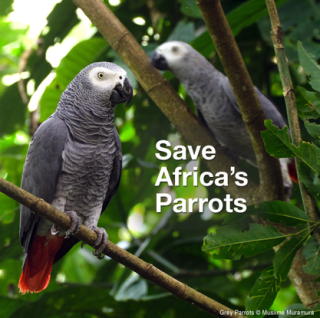Project Regions:
Save Africa’s Parrots |

www.parrots.org/africa
Project Status: Active | 2013 - current
Collaborators/Funders
Kenya Wildlife Service, Pandrillus Foundation, Last Great Ape Organization, Limbe Wildlife Centre, Lwiro Primate Rehabilitation Centre, Uganda Wildlife Education Centre, Disney Wildlife Rapid Response, Born Free Foundation, WWF Cameroon, Natural Encounters, Inc., Dees Family Foundation, Phoenix Landing Foundation, Columbus Zoo, Humane Society of the US (HSUS), Isdell Family Foundation, RSPCA, Pro Wildlife, Pan African Sanctuary Alliance (PASA), Ngamba Island Chimpanzee Sanctuary, Wildlife Conservation Society-Congo, Uganda Wildlife Authority, Bulgarian Ministry of Environment and Waters, Save Our Species (SOS), MAYA, GALF (Guinea-Application of the Wildlife Act), SALF (Senegal-Application of the Wildlife Act - in development), IBAP (National Institute for Biodiversity and Protected Areas), Dr. Paulo Catry (ISPA – Instituto Universitário, Portugal), Dr. Davide De Guz, The Wara Conservation Project (WCP), Pamela and Neville Isdell, BirdWatch Zambia, the Museum of Malawi and the Percy FitzPatrick Institute of African Ornithology at the University of Cape Town
The Plight of Africa's Parrots
Many parrot species are threatened with extinction. In Africa the problem is particularly urgent - parrots there face an increasing number of threats, from harvesting for the wildlife trade to habitat loss. There is also a lack of information on the issues facing African parrots. Recent efforts to address this shortfall have begun to fill in some of the knowledge gaps, but there remains much to be done.
Progress and outcomes: To help combat these problems, the World Parrot Trust has initiated the Africa Conservation Programme (WPT-ACP) to help protect parrot populations on the continent. The WPT-ACP aims to develop a number of pioneering directions in conservation and education that build on the World Parrot Trust’s long history of work in Africa.
Focus of future work: New research and conservation programmes are being developed and are providing the knowledge needed to best conserve populations while at the same time taking actions to address immediate threats. Education programs aim to engage the people that live alongside parrots in their conservation. Building early connections with those living among parrots establishes an appreciation for the impact of individual actions on the natural world. WPT is also working to eliminate the unsustainable trade in wild-caught parrots by aiding confiscation efforts and rescuing, rehabilitating and releasing birds caught in the trade. Further efforts include encouraging the enforcement of laws that protect parrots, supporting local and international awareness and education programs, and funding research into better understanding the trade region by region.
Grey and Timneh Parrots listed on CITES Appendix I
The wild bird trade and extensive deforestation have been devastating to Grey and Timneh parrots - with massive population declines occurring in nearly every country where they are found. Formerly widespread over much of Africa, Grey (Psittacus erithacus) and Timneh (Psittacus timneh) parrots are now threatened throughout much of their natural ranges. Both species have been uplisted on the IUCN Red List to Vulnerable in the wild on the basis of rapid population declines over three generations (47 years). Over 657,000 wild-caught birds, mostly P. erithacus, entered international trade from 1982-2001 (UNEP-WCMC 2003). The trapping of Greys and Timnehs is associated with a high mortality rate: upwards of 40-60% die before reaching point of sale.
To help address at least a part of the problem with trade the WPT initiated a campaign to petition CITES to uplist both Grey and Timneh parrots to Appendix I (meaning no commercial trade permitted). On October 2, 2016, after more than five years of collaboration with field partners, a petition with 75,000 signatures and new field data were presented at the Conference of the Parties for CITES 17. Delegates voted to uplist both Grey and Timneh parrots to Appendix I, ending commercial trade in wild birds. In December 2016, both species were uplisted by IUCN to Endangered.
Lilian's Lovebird Research Ongoing
A two-month expedition aimed at understanding the conservation needs of Lilian's lovebirds is underway in Zambia in 2015. Dr. Tiwonge Gawa, who recently won an award as a leading International Young Conservationist, is heading up a team of researchers to explore little-travelled areas of the Zambezi basin. The team, which includes researchers from the University of Edinburgh, BirdWatch Zambia and The Percy FitzPatrick Institute of African Ornithology, have collected data on the current distribution of Lilian's lovebirds and their habitat requirements.
Lilian's lovebirds are generally considered specialists of Mopane woodlands where they roost in mature trees but this habitat is under threat in southern Africa. Collaborations with researchers from the School of GeoSciences at the University of Edinburgh are helping understand changes in the status of key habitat. Studies of nest box use in Malawi and possibly Zambia will inform the widespread use of this approach for mitigating habitat loss. Water-holes vulnerable to pesticide poisoning are being protected through increased surveillance. Planning and implementation of educational awareness in schools and communities has begun.
Project Updates
Multimedia
Sorry, there is no multimedia for this project.































